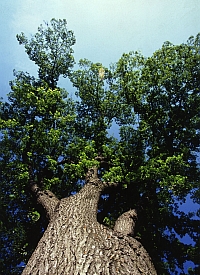Scientists from the Fraunhofer Institute for Microelectronic Circuits and Systems (IMS) in Duisburg, Germany have installed a wireless sensor system for micro-climatic monitoring on the grounds of the Northwest German Forestry Testing Facility in Göttingen. The IMS team believes the network can provide a very detailed picture about the environmental conditions on the site, without the considerable installation effort needed for a wired network.
Monitoring systems in forests record data on factors such as soil humidity or pollutant penetration at permanently installed stations. The data they generate help maintain the long term ecological stability of the forests. However, installing and maintaining a wired network of stations is complicated. Not only are the wired measuring devices complex to install and maintain, they also interfere with the natural growth of the forest being monitored.
In the system at Göttingen, sensor nodes are inserted into the soil or affixed to tree branches. Because the sensors are not connected with wires, changing the measuring positions, if needed, can be done without much effort. Data from the sensors are transmitted by cellular radio to a central tree stock database, aided by a mobile cellular modem connected directly to the sensor network.
A particular challenge faced by the project team is providing power to the sensor nodes. Solar power is not an option due to the low penetration of sunlight under the leafy canopy of the trees. As a result, network operators need to replace batteries regularly.
The network designers, however, have tweaked the software running the system so the batteries kick in only when they are actively collecting or transmitting data — some factors are more stable and require fewer collections of data over time. Otherwise, the batteries are in energy-saving “sleep” mode. These software enhancements have extended the lives of the batteries as long as 12 months.
Read more: HSBC Takes Climate Change Research to the Bank
* * *


 RSS - Posts
RSS - Posts
Wireless sensor network (WSN) is a kind of technology that integrates several advanced technologies including sensor, embedded computing, modern network and the wireless communication technologies. There is a wide applied space for this promising industry. With the development of modern technology, the WSN will have a profound influence on ares of medical practise.
Thanks John for your comment and for visiting Science Business. It is good to hear about the potential for wireless sensors, particularly in medical applications. – AK